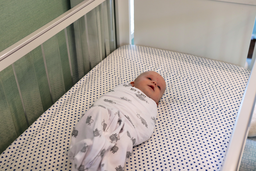When you’re talking about preventing plagiocephaly and torticollis, correct positioning is absolutely essential. No matter what you’re doing, correct positioning helps your child avoid flat head syndrome and a tight neck. For moms and babies who are breastfeeding, good positioning can affect so much more than the shape of the baby’s head.
Here are some suggestions that will ensure your baby gets enough to eat and you are comfortable while feeding.
When you sit down to nurse, make sure that both you and the baby are well supported. Sit in a comfortable chair, using pillows for support, with your back straight and your baby in the right position. There are very good products on the market that help with this and are easy to use. They help keep the baby comfortable and prevent you from slumping or hurting your neck/shoulders. Try using the different holds below until you find the one that works for both of you:
-
The Cradle Hold: This is the classic position, in which your baby’s head is cradled in the crook of your arm. This works well in a chair with supportive armrests or on a bed with plenty of pillows. Resting your feet on something can help you avoid leaning toward your baby. In this position, the baby lies across your lap on his or her side, with the face, stomach and knees facing you, and the lower arm under yours. Your forearm and hand should support the neck, spine and bottom, as your baby lies horizontally or at a slight angle.
-
The Cross Cradle: This is different from the previous hold, because your opposite arm supports the baby, with your hand under the head.
-
The Football Hold: Also known as the clutch, this position involves tucking your baby under your arm, just like a football. The baby should be under your arm, facing you, with the nose level with your nipple and feet toward your back. Resting your arm on a pillow, in your lap or beside you, support the baby’s head, neck and shoulders with your hand, using your forearm to support the upper back.
-
Reclining: Nursing while lying on your side is great if you’re recovering from a difficult delivery, if sitting is uncomfortable or if you just want some extra snuggle time. The secret to success with this position is to use pillows to keep your back and hips in a straight line, positioning one under your head and shoulders, one between your bent knees and several behind your back for support. If your baby needs to be higher to comfortably reach your breast, you can use a small pillow or folded receiving blanket under the head, so that reaching you is not a strain. For safety reasons, avoid falling asleep with your baby in this position. While it may be tempting in the middle of the night, it is not safe. Move your baby to a firm surface where he/she can sleep on his or her back. You will sleep better, too!
While breastfed babies need to be burped less than babies who are bottle fed, it’s still important to burp your baby if he or she seems squirmy or uncomfortable. Burping a baby prevents spit up and is especially helpful for babies with GERD, or reflux. You can burp the baby on your shoulder, on your lap or lay baby face down across your knees while gently rubbing or patting his or her back.
Proper positioning while nursing is also a great way to avoid plagiocephaly and torticollis. Be cognizant of where the pressure is on the baby’s head. Change frequently, avoiding pressure on the same spot day after day. If you see a flat spot starting to develop, discuss options with your lactation consultant or contact the experts at Baby Begin. We work to give babies the very best start in life, providing parents with information to help them prevent plagiocephaly and offering in-home therapy for children who need our help. Early intervention is important, so if you worry that your child is suffering from flat head syndrome, contact us as soon as possible. For more information about treatment of infant plagiocephaly, please visit our website or our Facebook, Twitter or LinkedIn.

